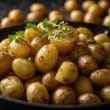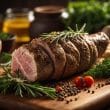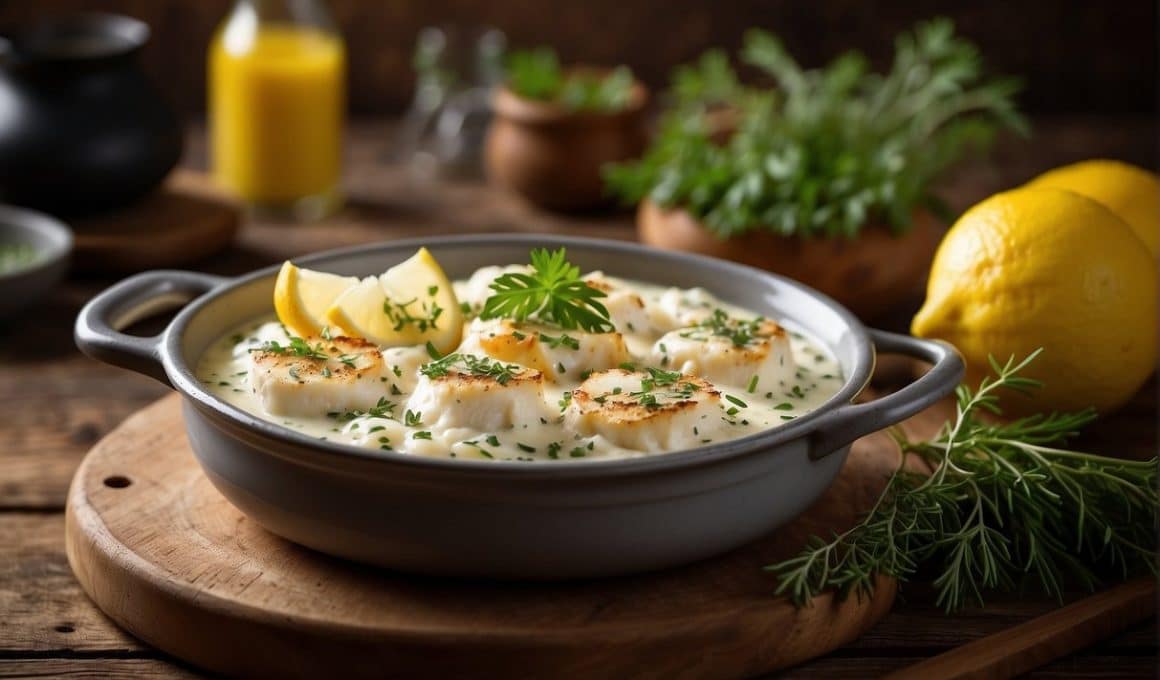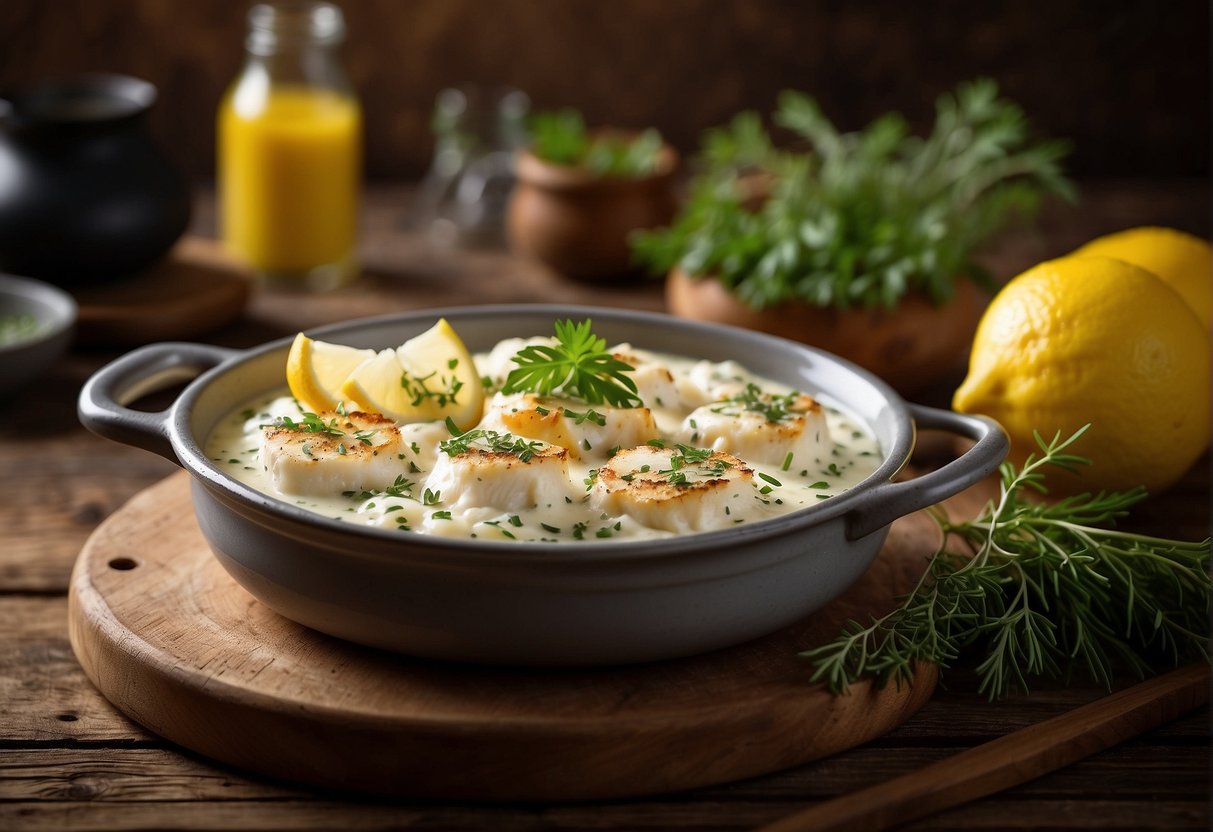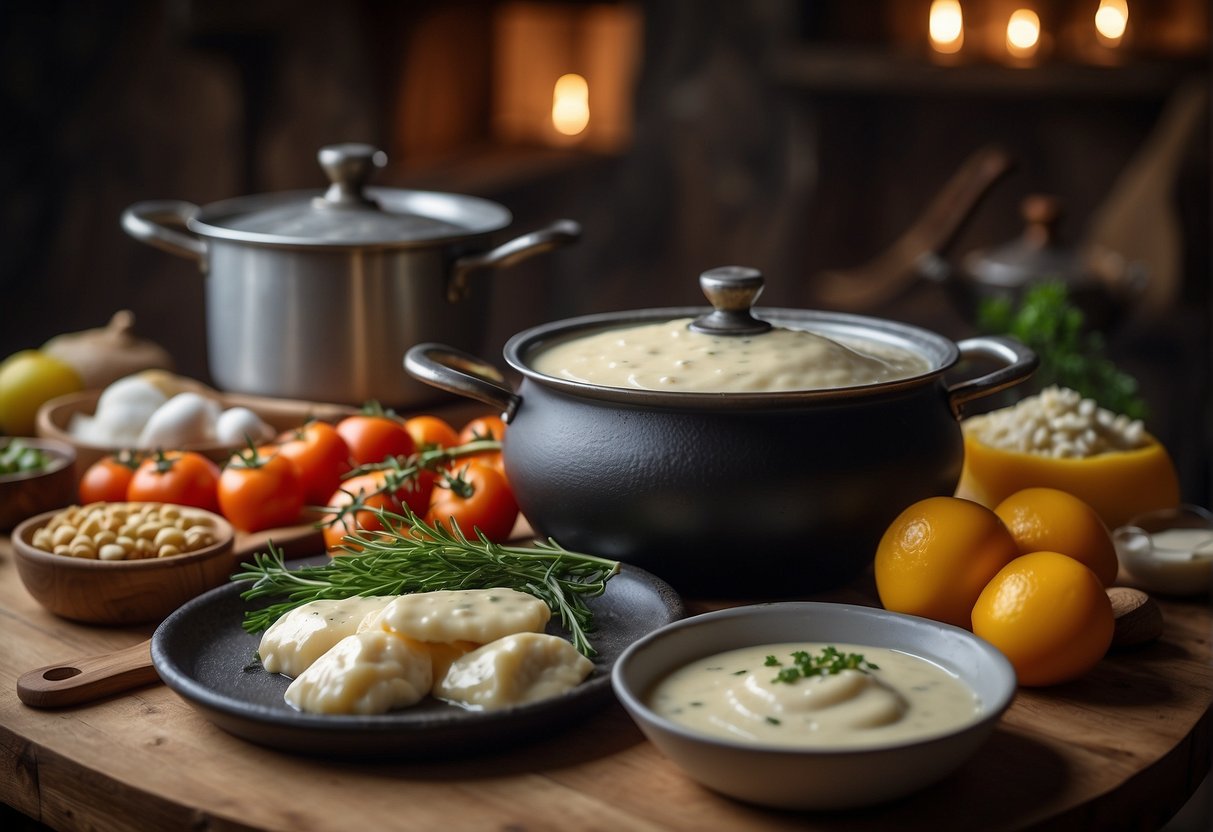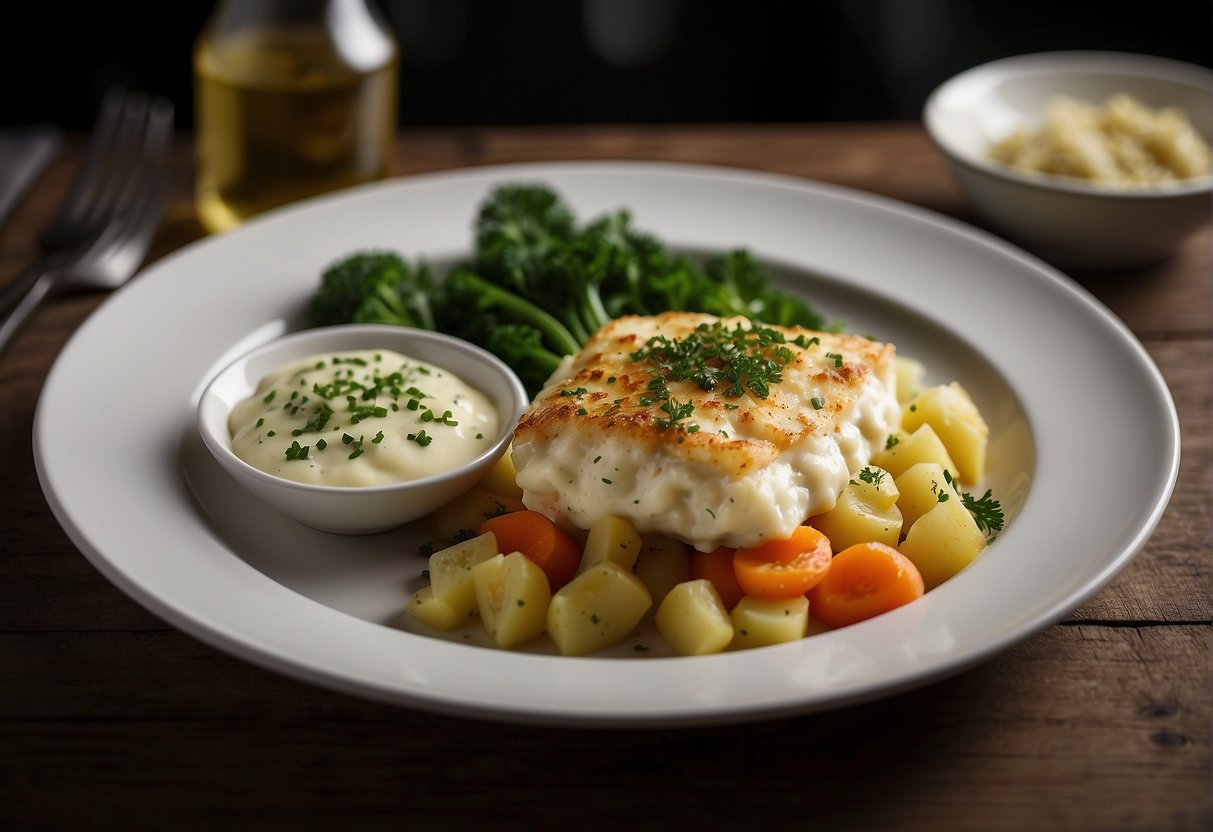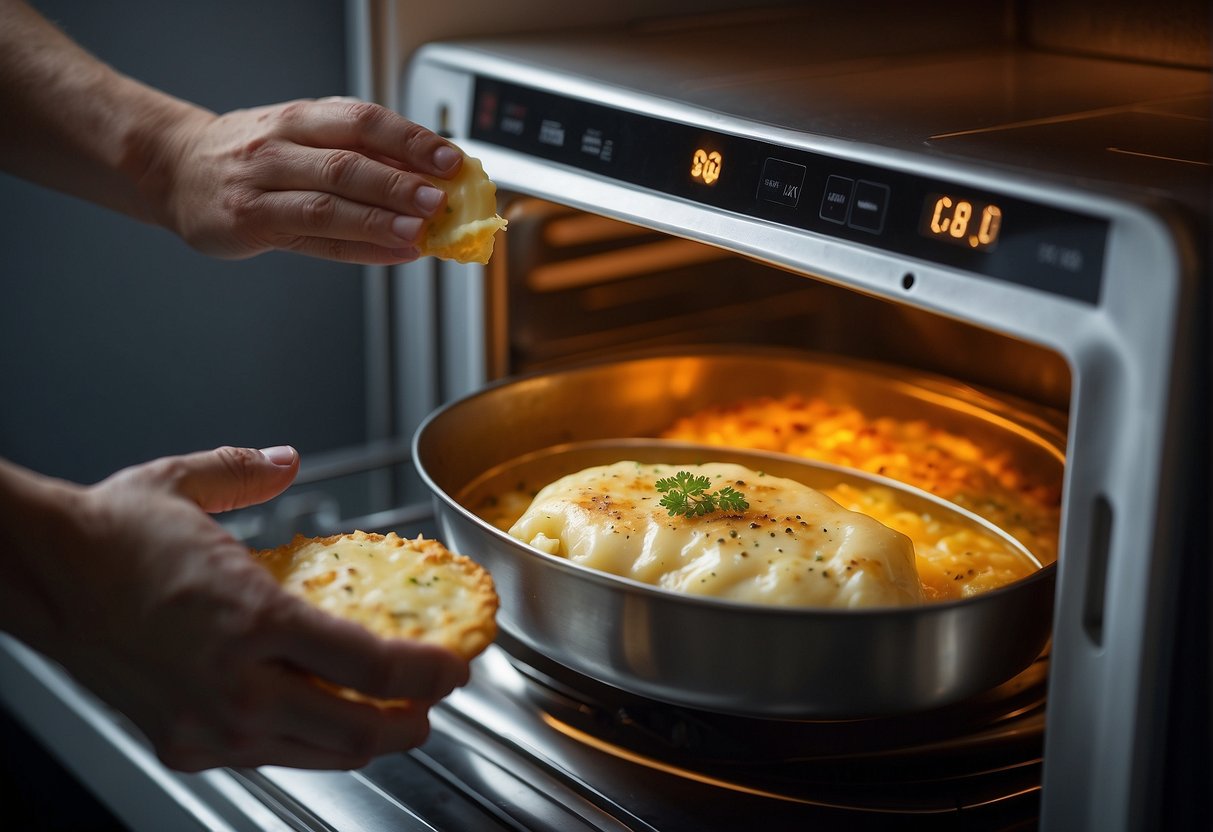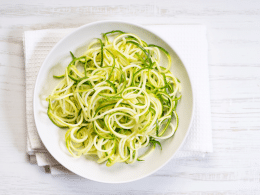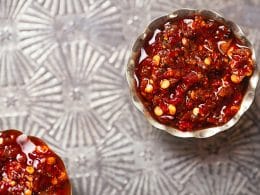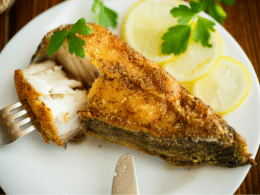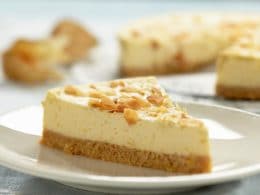Cod Mornay is a classic dish that has stood the test of time, offering a comforting and rich flavor profile that has made it a favorite in many households. At its heart, the dish features tender pieces of cod enveloped in a delicious Mornay sauce—a creamy concoction that brings together the warm notes of cheese and the savory depth of a roux-based white sauce. As a main course, Cod Mornay provides a satisfying meal that pairs perfectly with a variety of side dishes.
Preparing Cod Mornay involves a harmonious blend of simple yet high-quality ingredients that come together to create an indulgent experience. The process may vary slightly depending on personal or regional variations, but typically, a flaky and moist cod fillet is baked until just right and then draped in the luxuriously smooth sauce. With the right cooking technique and kitchen equipment, even novice cooks can achieve a sumptuous result reminiscent of a professional kitchen’s finesse.
Key Takeaways
- Cod Mornay is a beloved dish with a rich, cheesy sauce that complements the delicate flavors of cod.
- The preparation requires a careful balance of ingredients and cooking practices for optimal results.
- This dish serves as a versatile main course, fitting for a variety of dining occasions and adaptable to personal taste preferences.
History and Origin
The origins of Cod Mornay, a decadent French cuisine staple, are entwined with the history of its namesake, the Mornay sauce. For the uninitiated, Mornay sauce is essentially a béchamel sauce—one of the mother sauces of French cooking—enhanced with cheese. Through my culinary explorations, I have learned that the debate regarding the sauce’s namesake continues, with some attributing it to Philippe, duc de Mornay, a figure from the late 16th to early 17th century.
Understanding the timeline, it’s worth noting that béchamel, the foundation of Mornay sauce, was developed later; hence, early iterations of Mornay sauce might have been based on velouté, another mother sauce. Over time, classic Mornay sauce incorporated béchamel and cheese, often Gruyère or Parmesan, and sometimes additional ingredients like egg yolks and mustard to create a more complex flavor.
Traditionally, the harmony between Cod Mornay comes from the succulent flakes of cod enveloped in the rich, creamy texture of the Mornay sauce. French chefs of the 17th century are credited with its creation, though it seems the recipe evolved to include the cod and other ingredients to suit broader palates.
In my quest to understand this dish, I’ve discovered that Cod Mornay has undergone various adaptations. While the traditional recipe focuses on the synergistic flavors of the fish and sauce, modern renditions might introduce elements like onions, herbs, or even a touch of Worcestershire sauce for a depth of flavor.
It’s clear that Cod Mornay is an enduring classic, beloved for its creamy sauce and the way it compliments the delicate taste of cod. The evolution of this dish is a testament to the ingenuity of French cooks and their ongoing influence on world cuisine.
Ingredients
In crafting a traditional Cod Mornay, I ensure that there’s a balance of savory and rich flavors, combining nutritious fish with a creamy cheese sauce and complementary extras. Here’s a breakdown of the specific ingredients involved.
Main Ingredients
- Cod: A lean white fish, cod serves as the protein-rich base of the dish, offering a mild flavor that pairs well with the robust cheese sauce. It is a good source of vitamins and minerals, contributing to the dish’s overall nutritional profile.
- Salt: A pinch of salt is essential to enhance the flavors of the cod and the mornay sauce.
- Black pepper: Freshly ground black pepper adds a subtle heat and depth to the seasoning.
Mornay Sauce Components
- Butter: The starting point of the mornay sauce, crucial for creating a roux which serves as the thickening agent for the sauce.
- Flour: Plain flour is combined with melted butter to form a roux, capturing the rich essence without altering the flavor.
- Milk: Full-fat or semi-skimmed milk is whisked into the roux, transitioning it into a creamy white sauce, or béchamel, which forms the base for the cheese sauce.
- Cheese: A mix of grated cheeses, often a combination of gruyere and cheddar, melts into the béchamel to create the classic mornay sauce. These cheeses add complex flavors as well as calcium and other nutrients.
Additional Ingredients
- Breadcrumbs: These provide a satisfying crunch when sprinkled on top of the dish, and turn golden brown when baked.
- Parsley: Chopped parsley is sometimes used to add a fresh, herbaceous note to the final presentation, complementing the richness with its bright flavor.
- Sugar: Just a touch of sugar can balance the overall taste if needed, although its addition is not traditional.
Preparation Steps
When preparing Cod Mornay, precision in the steps ensures a delightful dish. I’ll cover how to properly prepare the fish, make a creamy Mornay sauce, and combine everything before baking to perfection.
Fish Preparation
Ingredients for the fish:
- Choice of white fish: cod loin, haddock, hake, or coley
- Boneless cod fillets (fresh or defrosted frozen fish)
Steps:
- I start by preheating the oven to 180°C (360°F).
- I then ensure my fish of choice, preferably cod loin for its meaty texture, is boneless and cut into even portions.
- If using frozen fish, I make certain to defrost it completely and pat dry to prevent excess water from making the sauce runny.
Sauce Preparation
Ingredients for the sauce:
- Butter
- All-purpose flour
- Milk
- Grated cheese (a mix of sharp cheddar or Gruyère works well)
Steps:
- Next, I melt butter in a saucepan over low heat.
- I mix in an equal amount of flour to butter until a paste, or roux, forms.
- Gradually, I whisk in milk until the mixture is smooth and thickens to form a basic béchamel sauce.
- To transform the béchamel into a Mornay sauce, I stir in grated cheese until melted and season according to taste.
Combining Ingredients
Equipment:
- Baking dish
Steps:
- I place the prepared fish in a single layer in a buttered baking dish.
- The fish is then covered with the Mornay sauce, ensuring even distribution.
- Optionally, I sometimes sprinkle extra breadcrumbs or cheese on top for a crispy finish.
- Finally, I bake the dish in the preheated oven until it’s golden and bubbly, which usually takes about 20 to 25 minutes.
Cooking Technique
When I prepare cod mornay, meticulous attention to the baking process and the final touches ensure a dish that is savory with a perfectly golden top. Careful temperature control and timing are crucial from start to finish.
Baking the Dish
Before anything else, I preheat my oven to the appropriate temperature, usually around 350°F (175°C), so it’s ready when my cod and sauce are. I lay my cod pieces in a single layer in a baking dish, ensuring the fish is spaced evenly. I then smother it with a rich, cheesy sauce that’s been gently simmered on medium heat until it is thick and velvety. To achieve the desirable golden brown appearance and a slightly crisp texture, I sprinkle breadcrumbs over the sauced fish before it goes into the oven. The cook time varies, but the key is to bake until you see the sauce bubbling around the edges, indicating the dish is thoroughly heated and the top has turned golden.
Final Touches
Once the dish is baked to perfection, I give it a few minutes to rest; this is to let the sauce settle and thicken a tad more. I take this opportunity to grate some Gruyère—which adds a delightful depth of flavor—and sprinkle it over the top. A light garnish of chopped parsley not only adds color but also a fresh, herby note that complements the creamy sauce. The total time from preparation to serving is essential to monitor, thus ensuring every element is at its best when I present the cod mornay to the table.
Serving Suggestions
In my experience, a well-thought-out serving suggestion can elevate the humble Cod Mornay from a simple meal to an exceptional dining experience. I focus on complementing textures and flavors that harmonize with the creamy cheese sauce of the mornay.
Accompaniments
- Potatoes: My go-to is Parmentier potatoes, which are cubed and roasted, providing a crunchy contrast to the softness of the baked cod.
- Vegetables: For added color and nutritional value, I incorporate steamed or roasted veggies like cauliflower, broccoli, and kale. Steamed peas are also a delight, offering a fresh burst in every bite.
- Garnish: A sprinkle of fresh parsley or chives adds both color and a subtle onion-like flavor that doesn’t overpower the dish.
Presentation Tips
- Plating: I serve individual portions of Cod Mornay in shallow bowls or plates to contain the creamy sauce.
- Garnish: A final addition of a lemon wedge on the side of the plate not only adds a pop of color but allows guests to add a fresh zest to their taste.
- Cauliflower Cheese: A side of cauliflower cheese can offer a rich, cheesy complement to the main course, making it a heartier meal.
Remember, how I present the Cod Mornay can greatly impact the dining experience. It’s not just about taste; the visual appeal is crucial in setting the stage for a satisfying meal.
Nutritional Information
When preparing Cod Mornay, I pay attention to its nutritional components. An average serving of Cod Mornay contains roughly 310 calories. As a nutritious meal, it offers a decent amount of protein with about 24.2 grams per serving, which is essential for muscle maintenance and repair.
In terms of fats, Cod Mornay is moderate in unsaturated fat, depending on the type of cheese and milk used. Opting for full-fat ingredients increases the unsaturated fat content, but using semi-skimmed alternatives can reduce it.
Sodium content in Cod Mornay can vary, but it’s wise to keep an eye on it, especially if pre-packaged ingredients are involved. An oven-ready Cod Mornay serving contains approximately 5.9 grams of sodium. Therefore, I make sure not to add extra salt during preparation to manage my sodium intake.
The dish also includes carbohydrates, amounting to around 10.1 grams per serving, with a minimal contribution from fiber. The fiber content could be increased by incorporating more vegetables like kale, which also contributes additional flavors and nutrients.
The nutrition facts for Cod Mornay usually show a breakdown of percent daily values based on a 2,000 calorie diet, which can help in understanding how a serving fits into my daily nutritional goals. It’s important to check the nutrition labels for precise values, as these can differ based on the exact recipe and ingredients used.
Here’s a quick rundown in table form for clarity:
| Nutrient | Amount per serving |
|---|---|
| Calories | 310 |
| Protein | 24.2g |
| Unsaturated Fat | Varies |
| Sodium | 5.9g |
| Carbohydrates | 10.1g |
| Fiber | Minimal (can be increased with vegetables) |
Remembering these details helps me keep my meals balanced and nutritious.
Storage and Reheating
Proper storage and reheating are crucial for maintaining the quality and safety of Cod Mornay leftovers. Here’s how I do it.
Storing Leftovers
When storing Cod Mornay, I ensure it cools down to room temperature before placing it in the fridge. I use an airtight container to keep the moisture intact and avoid contamination. The shelf life in the refrigerator is typically two to three days. If I need to store it longer, I freeze the dish by wrapping it tightly with foil or placing it in a freezer-safe container. In the freezer, Cod Mornay can last for up to one month.
Reheating Guidelines
To reheat Cod Mornay, I preheat the oven to 350°F (175°C). The dish should be placed in an oven-safe container, covered with foil to prevent it from drying out. Reheating times vary, but it usually takes about 10-15 minutes. Alternatively, Cod Mornay can be reheated in the microwave for quickness. I use a microwave-safe dish, cover it, and set the microwave to a medium setting, checking periodically to avoid overcooking.
Variations and Substitutes
In my experience with cod mornay, one of the recipe’s advantages is its flexibility. I can easily adapt it to suit different tastes, dietary restrictions, or to simply work with what I have in my kitchen. Here’s how I adjust the fish, cheese, and additional seasonings.
Alternative Fish Options
If cod isn’t available or to your liking, you have plenty of options. Salmon or monkfish work wonderfully for a richer flavor and firmer texture. If you prefer a lighter taste, any white fish like haddock can be substituted without compromising the dish.
Cheese Variations
Gruyère cheese is often used for its excellent melting qualities and subtle sweetness, but it’s not your only choice. For a sharper taste, I find that cheddar cheese, when grated and melted, is an equally delightful alternative. The type of cheese you choose can significantly alter the final flavor profile of the mornay sauce.
Seasoning and Extras
Flavorings and additions can really make the dish your own. I like to incorporate breadcrumbs for a crispy topping, and tossing parsley into the sauce or as a garnish for a fresh note is always a good idea. For seasoning, a generous pinch of black pepper enhances the overall taste, and don’t hesitate to sprinkle on some extra cheese for grating on top before baking for an added cheesy crust.
Kitchen Equipment
When I prepare Cod Mornay, having the right kitchen equipment is essential to ensure the dish turns out perfectly. Here’s what I use:
- Baking Dish: A sturdy, oven-proof baking dish is crucial. It needs to be large enough to lay the cod pieces flat without overlapping. I prefer using a ceramic or glass dish, which promotes even cooking.
- Saucepans: I use two different sizes. A medium saucepan is ideal for preparing the Mornay sauce, while a smaller one can be used if I need to melt butter or warm milk separately.
- Whisks: A good-quality balloon whisk is my go-to tool for making smooth, lump-free sauces. Its shape allows me to incorporate the milk into the roux effectively.
- Additional Equipment:
- Chef’s Knife: To chop any additional ingredients.
- Measuring Cups and Spoons: For accurate ingredient quantities.
- Grater: For shredding cheese.
Here’s a quick checklist in a tabular format:
| Equipment | Purpose |
|---|---|
| Baking Dish | To bake the cod and sauce |
| Medium Saucepan | For preparing the Mornay sauce |
| Small Saucepan | For melting butter or warming milk |
| Balloon Whisk | To ensure a smooth sauce |
| Chef’s Knife | For cutting any extra ingredients |
| Measuring Tools | For accurate measurements |
| Grater | For cheese needed in the sauce |
With these tools, I find that making Cod Mornay is straightforward, and the result is consistently delicious. Good equipment really does make a difference.
Cooking Tips and Tricks
In my experience, a successful Cod Mornay hinges on three vital components: a perfectly balanced sauce, properly prepared fish, and mastering baking techniques. I’ll walk you through these aspects to ensure your dish is a triumph.
Consistency of Sauce
When crafting my béchamel sauce for the Cod Mornay, I ensure the consistency is just right. The key is to use a roux as the thickening agent. For a sauce that’s velvety and clings to the fish, I use equal parts butter and flour, stirring continuously to avoid clumps. Then, I gradually whisk in milk, resulting in a thick base before layering in grated cheese to transform it into a rich Mornay sauce.
- Top tip: For a fail-safe roux, melt butter over medium heat and whisk in flour until a paste forms, cooking it for a couple of minutes before adding milk.
Preparing Fish
I carefully prepare the cod—using fresh, skinless fillets is my preference. If the cod is frozen, I always thoroughly defrost before using it. Patting the fish dry is my secret to preventing excess moisture from making the sauce runny. If I’m dividing the filets into smaller pieces, I ensure they are even in size for uniform cooking.
- Prep: To ready the cod, defrost completely, gently pat dry, and set in a baking dish without overlapping.
Baking Techniques
Before baking, I preheat the oven—it’s essential for even, consistent cooking. My goal is to obtain a golden brown crust with a sauce that’s gently bubbling at the edges. I use a moderate baking temperature and keep a watchful eye on the dish. The precise baking time varies, but I start checking around the 20-minute mark.
- Bake: Always preheat your oven to the temperature suggested in the recipe, and bake until the topping is golden and sauce bubbles with promise.
Frequently Asked Questions
In this section, I tackle some common queries about preparing and enjoying cod mornay, focusing on practical advice for crafting this classic dish.
What ingredients are needed to prepare a classic cod mornay?
A classic cod mornay requires cod fillets, a rich cheese sauce made with ingredients like butter, flour, milk, and a variety of cheeses, such as Gruyère or cheddar. The dish is often finished with breadcrumbs for a crispy topping.
How is cod typically served with mornay sauce?
Cod mornay is traditionally baked in the oven, allowing the mornay sauce to meld with the fish, creating a creamy and savory experience. It’s usually served piping hot, straight from the oven.
What are some easy recipes for cod mornay suitable for beginners?
For those new to the kitchen, there are simple cod mornay recipes that involve a straightforward preparation of the cheese sauce, laying the cod in a baking dish, pouring over the sauce, sprinkling with breadcrumbs, and baking until golden.
What are the steps to make a cod mornay like Jamie Oliver?
While I don’t have a direct recipe from Jamie Oliver for cod mornay, the general steps would involve seasoning the cod, preparing a homemade cheese sauce, combining them in a baking dish, and cooking until the fish is tender and the sauce is bubbly.
How can you describe the taste and texture of cod mornay?
Cod mornay has a delicate, flaky texture with the creaminess of the mornay sauce complementing the mild, sweet flavor of the cod. The breadcrumb topping adds a satisfying crunch.
What distinguishes mornay sauce from other cheese sauces in culinary terms?
Mornay sauce is a Béchamel sauce—a classic white sauce made from butter, flour, and milk—plus cheese. What sets it apart is the inclusion of hard, aged cheeses, often emmental or Gruyère, which provide a depth of flavor distinguishing it from simpler cheese sauces.


